After lights-out yesterday, I investigated the reclining options on Amtrak coach seats. So, you get perhaps 45 degress, and there is a footrest you can somehow fiddle out using a somewhat steampunky lever:

A Night in Coach Class
I think I'd still not have slept very well if there had been someone in the seat next to mine. There was no danger of that for the major part of the night, though, as not many people weathered the dead of the night in the coach class.
One reason why nights in the coach class may be uncomfortable is that the train still stops at stations even in the dead of night, and so around 4 am suddenly the car filled up. Starting a journey in the positively wee hours seems a fairly unattractive proposition to me. It obviously was attractive enough to what seemed like a few dozen people who entered the car somewhere in upstate New York (Buffalo?). I clearly have dropped back into a fairly deep sleep after that, though, because when I awoke for the next time, perhaps around 5:30, the car was pretty empty again.
Even without that sort of interruption, crouching in the admittedly spacious seats would not work for me for much more than one night. I am therefore very grateful to my former self that decided I wanted a sleeper on the Chicago-Tucson leg of this journey.
Meanwhile, around 8 am EDT, we have passed Waterloo, Ohio and are rolling through a dawn over an open landscape. The forests we were in when the sun set have given way to endless fields with the occasional farm. Many of these fields are not bare but have something on it. It's still too dark to see what it might be. At the beginning of November, the farmers certainly have brought in their harvest (or do they?), so I suppose it'll be some sort of anti-erosion and maybe green manuring plan?
Being able to perceive a bit more than assorted lights when looking out of the window (just now: a large „Home of the Apple festival“ mural) makes me regret a bit that we passed upstate New York during the night. But then: I needed the sleep, too.
South Bend, Indiana (9:40)
Sunrise was somewhere in the region of the Ohio/Indiana border:
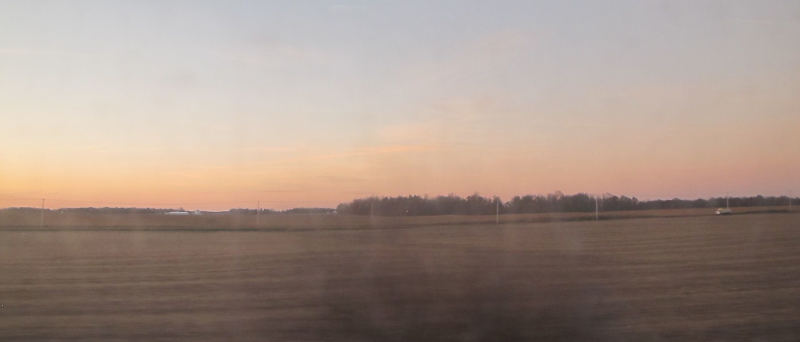
Since then, we have been passing though what, I suppose, passes as the rust belt – an endless succession of business districts and freight trains. At the same time, the train goes rather slow now – perhaps because there are, of course, many road crossings now, perhaps because the rails we are on are now less well maintained than they were in New York. On that topic, if you read Amtrak#on time performance in the Wikipedia, you get an idea of what odds Amtrak faces: it leases most of the tracks it runs on from freight train companies. Unsurprisingly, this only barely works, and severe regulation was required to fix the most egregious failures. Still, it's not easy to think of a system that's less likely to work properly than that.
Nachtrag (2023-11-15)
Actually, it seems quite a bit of that regulation has been repealed, or at least that is what the conductor said on the last day of my Amtrack experience on Nov 5, when the train was waiting just a few kilometres in front of Tucson for the tracks in the station to clear. We were a few minutes before schedule before that standstill, and were one hour delayed when we actually arrived.
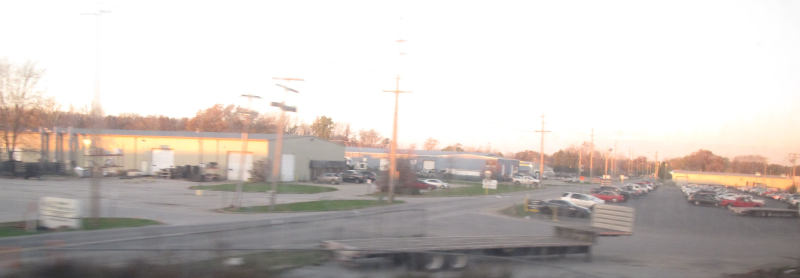
I have not seen very much rust as such while passing through Ohio and Indiana – but quite a lot of industry that is not really pleasant to the eye either.
In that sense, it is particularly depressing that in Germany, there are serious voices that want to move rail operations into a similar direction. They claim that the mess that Deutsche Bahn (DB) is at this time could be improved by founding a separate “non-profit“ for maintaining the railways proper, whereas for-profits (of course, heavily subsidised by the public hand; at least no public voices betray illusions it could work in any other way) would operate the trains.
I always have a hard time maintaining my assumption that there are basically well-meaning people at work here. Evidently, ever since high-payed executives replaced public servants in Bahn management, things have been steeply downhill, and with an increasing administrative overhead on top (cf. this post in German).
Why anyone would believe that doing more of what broke matters would suddenly turn around the steep downhill dive is beyond me. The sad thing is that we know how to do it better: Just go back to the state before DB became this wild construct of nested companies and make it run by public service workers again. No doubt: we can improve from there. But continuing in the direction of where Amtrak already is clearly is a bad idea.
Meanwhile, some time this morning a colourful bunch boarded the train: men with enormous hats, women with pious bonnets. I am too shy to directly ask them, but I could very well imagine they are Pennsylvania Dutch travelling by rail for religious reasons. Which I would find oddly charming.
Amenities on the Train (9:40 CDT)
We are approaching the Indiana-Illinois border, which means that we will change the time zone. That made me notice that in this car there is no clock, and no monitor either that could inform passengers about where we are, about stations and connections. That's one thing DB increasingly gets right, even though I will give you that these information screens are frequently broken, and when they give wrong information, they are admittedly worse than useless.
Anyway, on timezone-crossing means of traffic I think there should be some indication of the current local time, in particular when there may be connecting trains to catch. And that made me think about the other amenities on this train. Importantly for a train running that far, there is something like a dining car, where this morning I had hot oatmeal and a hot tea. This was not too bad; better than what DB has on its modern IC trains, significantly worse than what they have in their ICEs. Again, the Wikipedia on Amtrak has the story:
In 2006, Amtrak received just under $1.4 billion [in government subsidies], with the condition that Amtrak would reduce (but not eliminate) food and sleeper service losses. Thus, dining service was simplified and now requires two fewer on-board service workers. Only Auto Train and Empire Builder services continue regular made-on-board meal service.
So, that's why the food options are rather limited (to meals preparable by “add hot water“ or “microwave it“) But well: for a train as short as this, I'd say the diner is ok. Plus, there is this piece of 1960ies design at one end of the car:
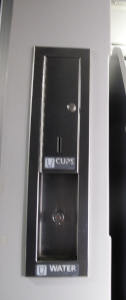
This isn't HAL. No: you can obtain cold water from there, if somewhat inconventiently because the tap is too low for anything but very small cups. Now, this is the one thing where the Transsiberian can serve as a model. There, they have a 24/7 samowar, heated with coal when the cars are without electricity on the Russian-Chinese border:
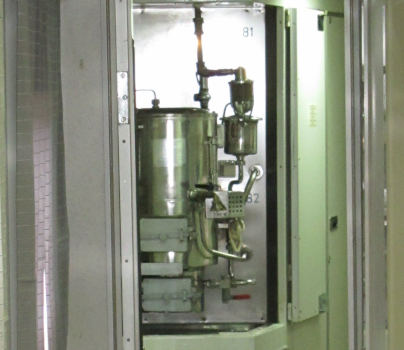
Now we are approaching Chicago, which is another amenities issue: It's really nice that there's so much overhead space for luggage in these Amtrak cars, in particular when compared to the lousy IC2 of DB. But I have bumped my head at least five times on this overhead storage rack in the past 22 hours. Let's see whether I will finally have learned that lesson.
At the Union Station in Chicago (13:00)
When there is just one train per day, I suppose one needs to be grateful if the connecting train departs a mere three hours after your arrival. Anyway, that's how I got to spend some time at Chicago's Union Station before my next train, the, gasp, Texas Eagle departs towards Tucson. The invaluable Wikipedia article on Amtrak has taught me that that's the fourth busiest station on the entire network. Given that, it's somewhat sobering that there is still just about one departure per hour.
Plus, where I'm sitting now feels a lot more like an airline gate than like a train station:
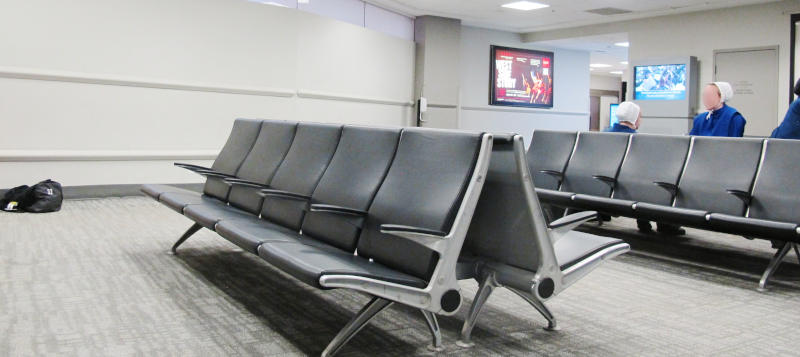
For reference, this is what a DB station tends to look like:
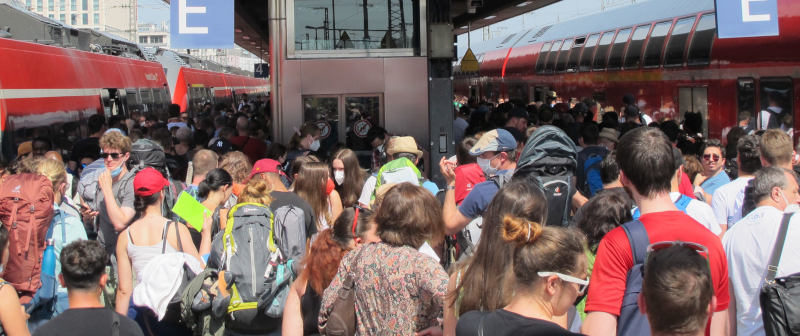
That was in Nürnberg in June 2022, that is, while the 9 Euro ticket was in effect[1]. Granted, it was a bit on the extreme side, and it's certainly not the way to win people for rail traffic. But wouldn't you agree that the lower photo feels a lot railier than the Union Station “gate” (they actually call it that) above?
And then the Union Station has a „great hall“ that does feel a bit railier as well, but also still feels oddly out of place – the thing would fit much better where tens of thousands of people pass through each day – and out of time: I'm not even quite sure which sort of historicism this is supposed to be:
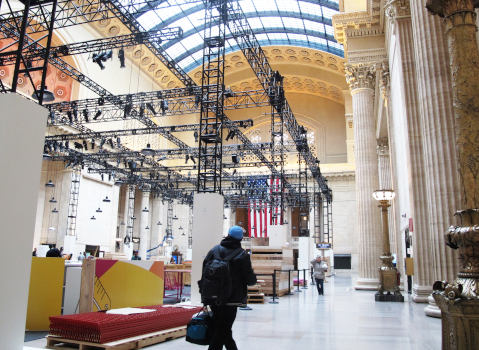
Finally, even though there's so little traffic here, I am again unsure whether the gate I'm sitting in is the right one for the Texas Eagle. Well: I still have an hour to work that out.
On the Texas Eagle (16:00 CDT)
For those old enough to remember the song und remote enough from Amtrak to not know about this anyway: There still is a train called City of New Orleans. It still runs between New Orleans and Chicago. And today, it was a whopping three and a half hours delayed:
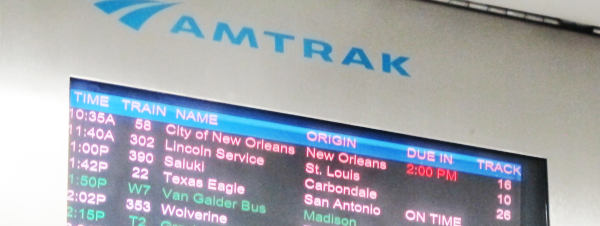
That's in one league with Deutsche Bahn all right.
Be that as it may, for me, getting the Texas Eagle worked out, even though the part with “train pulls out” that the song mentions turned out to be difficult; we were stuck even before we emerged from the concrete catacombs that so many US train stations have instead of proper platforms. Incidentally: why? I always find that rather oppressing, in particular when combined with the Diesel engines so common here.
But eventually, they let the train leave the station. I have already confessed that for the long haul I am indulging myself with an “economy bedroom“ (see Wikipedia on Superliner), which gives me a bedroom I'll likely have to myself:
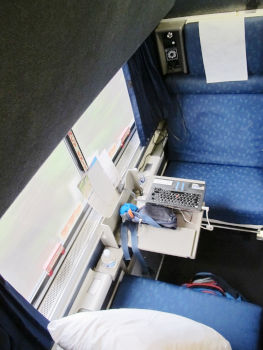
At least up to now it does not seem as if the second seat in here would be occupied. That's not good for my CO₂ footprint, but I will admit it's very convenient, in particular after all the sneezing and coughing in the coach car from Boston. And I get to view in placid contemplation what Steve Goodman described in 1970 in the song linked to above about how the City of New Orleans embarked from Chicago:
Illinois Central Monday morning railFifteen cars and fifteen restless ridersThree conductors and twenty-five sacks of mailAll along the southbound odysseyThe train pulls out at KankakeeRolls along past houses, farms and fieldsPassin' towns that have no namesFreight yards full of old black menAnd the graveyards of the rusted automobiles
Or, alternatively, I feel as if I were in the opening scene of Blues Brothers with the hellish images of Chicago refineries and smelting operations. As in:
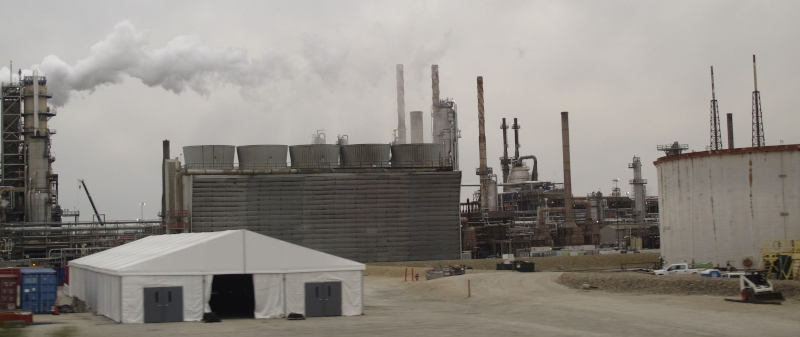
On the other hand, these days my more serious concern is about the huge fulfilment centres (is that what they call it?) that Amazon operates just about everywhere. This one one can see from the train near Joliet, IL:

The Internationale (17:20)
We were just standing ten minutes something like a kilometer outside of the Lincoln, IL station; the conductor explained that there was a northbound train still on the rail and we had to wait for it to pass us. I immediately felt right at home. At Deutsche Bahn, the exact same message reads “wir müssen noch etwas warten, bis der vor uns liegende Streckenabschnitt frei ist“.
This is the Internationale of the Optimised Railroads, where there's no metre of rail over and above what is absolutely necessary for regular operations. Of course, with his sort of optimisation as soon as something a bit unforseen happens, you immediately have breakage. And there you have part of the secret of the precision of the Swiss railway: just keep a bit of extra infrastructure above the absolute minimum.
In the Sleeper (20:00)
When the train window became too boring for lack of light, I showered off the night in the coach class. I liked the Superliner showers rather well: sufficient flow, good temperature regulation, reasonably much space, and a working separation between the wet part and the hopefully dry part.
You could argue that the brief instruction panel inside the shower may be overdoing matters:
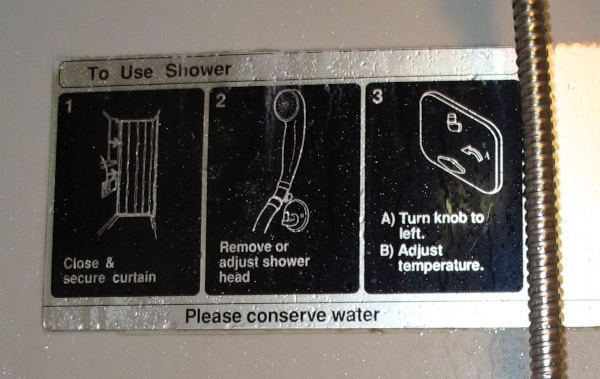
But then… without the sign I would probably have missed the snap fasteners along the shower curtain, and these are really useful (when you are unlucky enough not to have a rigid shower cabin). Just one thing: In case you ever design a sleeper train shower, plan for a few more clothes hangers. People rarely go from their cabins to the showers in just a bathrobe on a train. If, on the other hand, you enter in your usual train attire, there's quite a bit to hang.
That's probably even more true in Amtrak trains, as both in the Lake Shore Limited yesterday and in the Texas Eagle today, the attendants sternly insisted people wear shoes when moving around in the train, apparently out of concern they might otherwise slip. Does anyone know the background of this story? Did someone sue for damages because they let them walk barefoot in the train? But what damages would these have been?
A Capital with a Short Platform
Before that, I was somewhat taken aback that Springfield, the state capital of Illinois, apparently has a fairly small station. Consider this montage:
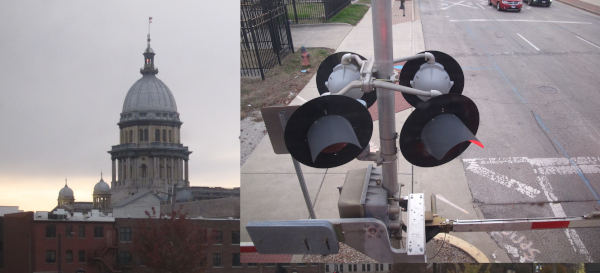
On the left, there's the state capitol for symbolic value. Also, one could see it from where the train stopped. And the train stopped such that the sleeper car stood with its exits in the midst of a railway crossing – the bulk of the train was on the rear side of that crossing, the engine on the front side.
Ok, there is some pragmatism to this, because presumably nobody going from Chicago to Springfield will ride in the sleeper car. But still, for a capital to have such a short station would suggest either a particularly humble government or a government remarkably indifferent of rail travel.
Mind you, Deutsche Bahn has occasionally disconnected a few capitals of a German Länder (member states), too. Doing some resarch now, however, it seems all the different governments actually cared about getting re-connected. Today I learned…
Entering the West (20:30)
The sleeper car has a conductor of its own who occasionally makes his own announcements, and even in Chicago he brought a timbre of Texas and the Old West into the car.
Now, whoever does the train-wide announcements has changed in St. Louis, the city of Anheuser Busch and the self-proclaimed gateway to the West. Sure enough, their explanations about wearing shoes while moving and avoiding cusswords while on Amtrak premises now had a very Western twang, too.
They gave us a printed train schedule: We will cross the rest of Missouri and Arkansas during the night, and if we make up the various delays will have our first stop in Texas at 7:40, just when I plan to be about done with my breakfast. That'll be my first time in Texas ever. From the comfort of my sleeper car, I think I look forward to that with about zero apprehension, despite all the prejudices one has after having watched Easy Rider once to many.
| [1] | Believe it or not: Back then you could ride any regional train or bus for a flat fee of 9 Euro per month. All over Germany. The stuff that legends are made of, as evinced by this grafitto someone left on the waiting bench at a tram stop in Dossenheim: 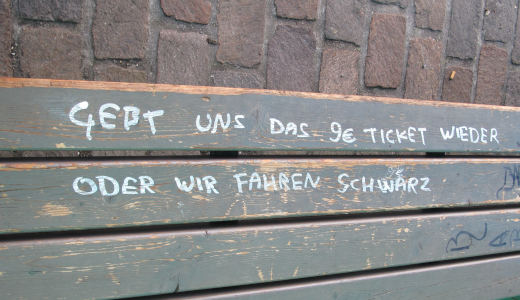
That's “Give us back the 9 Euro ticket. Else we'll dodge the fare. |
Zitiert in: Dossenheim to Malta: Day Two Boston-Tucson on Amtrak: Day 3 A DB User on Amtrak: Boston to Chicago
![[RSS]](./theme/image/rss.png)